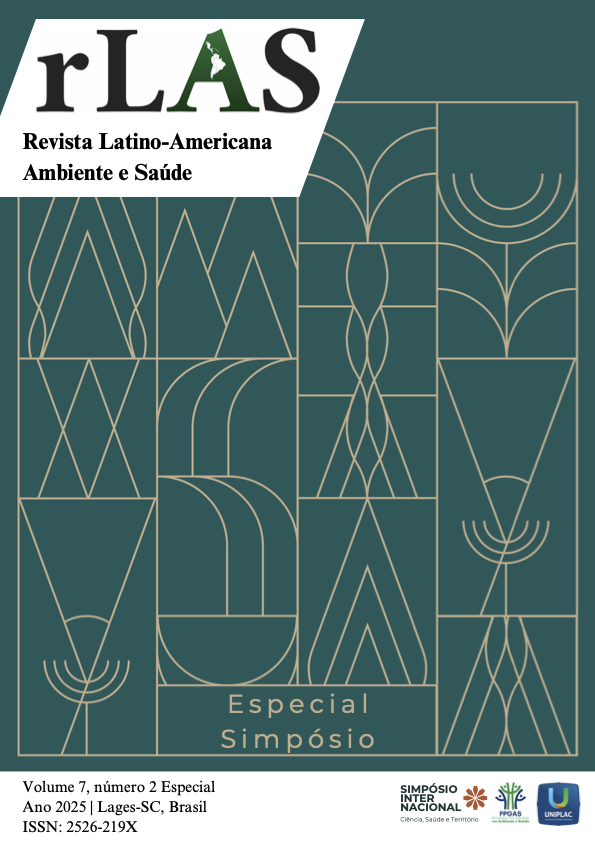Home-based physiotherapy practice and the influence of the family environment on the rehabilitation of patients with cerebrovascular accident
Keywords:
Cerebrovascular diseases, Rehabilitation, Social supportAbstract
Introduction: Neurological pathologies are responsible for cognitive and sensorimotor impairments, with Stroke (Cerebrovascular Accident - CVA) being one of the most prevalent conditions among the Brazilian population. The high number of cases in the country is concerning, as stroke significantly compromises individuals’ functionality and negatively impacts their quality of life. Objective: To identify, in the literature, the relationship between home-based physical therapy and the influence of the family environment on the rehabilitation of stroke patients. Methodology: A literature review was conducted using the SciELO, PubMed, and Google Scholar databases, with the following descriptors: "Stroke," "Home Physical Therapy," "Rehabilitation," and "Family." Results: Twenty-five articles were selected for this review. The studies demonstrated that home-based physical therapy contributes to improvements in joint mobility, balance, and patients’ functional independence. Regarding the family environment, it was found that the active involvement of family members in the rehabilitation process supports treatment adherence through encouragement and emotional support. Conclusion: Physical therapy assistance in the home setting, combined with family support, stands out as an important predictor of better prognosis in post-stroke patient rehabilitation.
References
BETTGER, J. P. et al. Hospital variation in functional recovery after Stroke. Circulation: Cardiovascular Quality and Outcomes, v. 10, n. 1, Jan 2017.
BOCCHI, S. C. M.; ANGELO, M. Interação cuidador familiar-pessoa com AVC: autonomia compartilhada. Ciência & Saúde Coletiva, v. 10, p. 729-738, 2005.
BOAS, C. C. S. V.; PERRINO, L. A. R. A Importância da Fisioterapia Domiciliar em Pacientes Pós Acidente Vascular Cerebral (AVC). Fisio e Terapia, v. 114, Set 2022.
BRITO, E. S.; RABINOVICH, E. P. Desarrumou tudo! O impacto do acidente vascular encefálico na família. Saúde e Sociedade, v. 17, p. 153-169, 2008.
CONNOR, E. O. et al. A qualitative evidence synthesis exploring people after stroke, family members, carers and healthcare professionals’ experiences of early supported discharge (ESD) after stroke. Plos One, v. 18, n. 2, p. e0281583, 2023.
FELÍCIO, D. N. L. et al. Atuação do fisioterapeuta no atendimento domiciliar de pacientes neurológicos: a efetividade sob a visão do cuidador. Revista Brasileira em Promoção da Saúde, v. 18, n. 2, p. 64-69, 2005.
FRENCH, B. et al. Repetitive task training for improving functional ability after stroke. Cochrane Library, v. 11, n. 11, Nov 2016.
GARANHANI, M. R. et al. Adaptação da pessoa após acidente vascular encefálico e seu cuidador: ambiente domiciliar, cadeira de rodas e de banho. Acta Fisiátrica, v. 17, n. 4, p. 164-168, 2010.
KURIAKOSE, D.; XIAO, Z. Pathophysiology and Treatment of Stroke: Present Status and Future Perspectives. International Journal of Molecular Sciences, v. 21, n. 20, Out 2020.
MINELLI, C.; FEN, L. F.; MINELLI, D. P. Stroke incidence, prognosis, 30-day, and 1-year case fatality rates in Matão, Brazil: a population-based prospective study. Stroke, v. 38, n. 11, p. 2906-2911, Nov 2007.
MELO, L. S. Fatores Epidemiológicos, Clínicos e Funcionais de Pacientes com Acidente Vascular Cerebral. 2016. 153p. (Doutorado em Fisioterapia) - Universidade Federal do Rio Grande do Norte, Natal, 2016.
MELO, R. M. C.; RUA, M. S.; SANTOS, C. S. V. B. Family caregiver’s needs in caring for the dependent person: an integrative literature review. Revista de Enfermagem Referência, v. 4, n. 2, p. 143-151, Jun 2014.
NASCIMENTO, L. R. et al. Home-based exercises are as effective as equivalent doses of centre-based exercises for improving walking speed and balance after stroke: a systematic review. Journal of Physiotherapy, v. 68, n. 3, p. 174-181, 2022.
OLIVEIRA, L. G. Contributos do Serviço Social no Acolhimento, Acompanhamento e Preparação da Alta de Doentes Internados em Unidades de Cuidados Continuados Integrados. 2016. 114p. (Mestrado em Serviço Social) - Universidade Fernando Pessoa, Porto, 2016.
RAMALHO, V. C. C. Cuidados no domicílio em doente com AVC após alta da UCCI. 2014. 177p. (Mestrado em Psicogerontologia Comunitária) - Escola Superior de Educação de Beja, Beja, 2014.
RAYEGANI, S. M. et al. Evaluation of complete functional status of patients with stroke by Functional Independence Measure scale on admission, discharge, and six months poststroke. Iranian Journal of Neurology, v. 15, n. 4, p. 202-208, Out 2016.
SAÚDE, Organização Mundial. Manual STEPS de Acidentes Vascular Cerebrais da OMS: enfoque passo a passo para a vigilância de acidentes vasculares cerebrais. Genebra: OMS, 2006. Disponível em: http://pt.scribd.com/doc/46616252/Avc-Livro-Oms.


